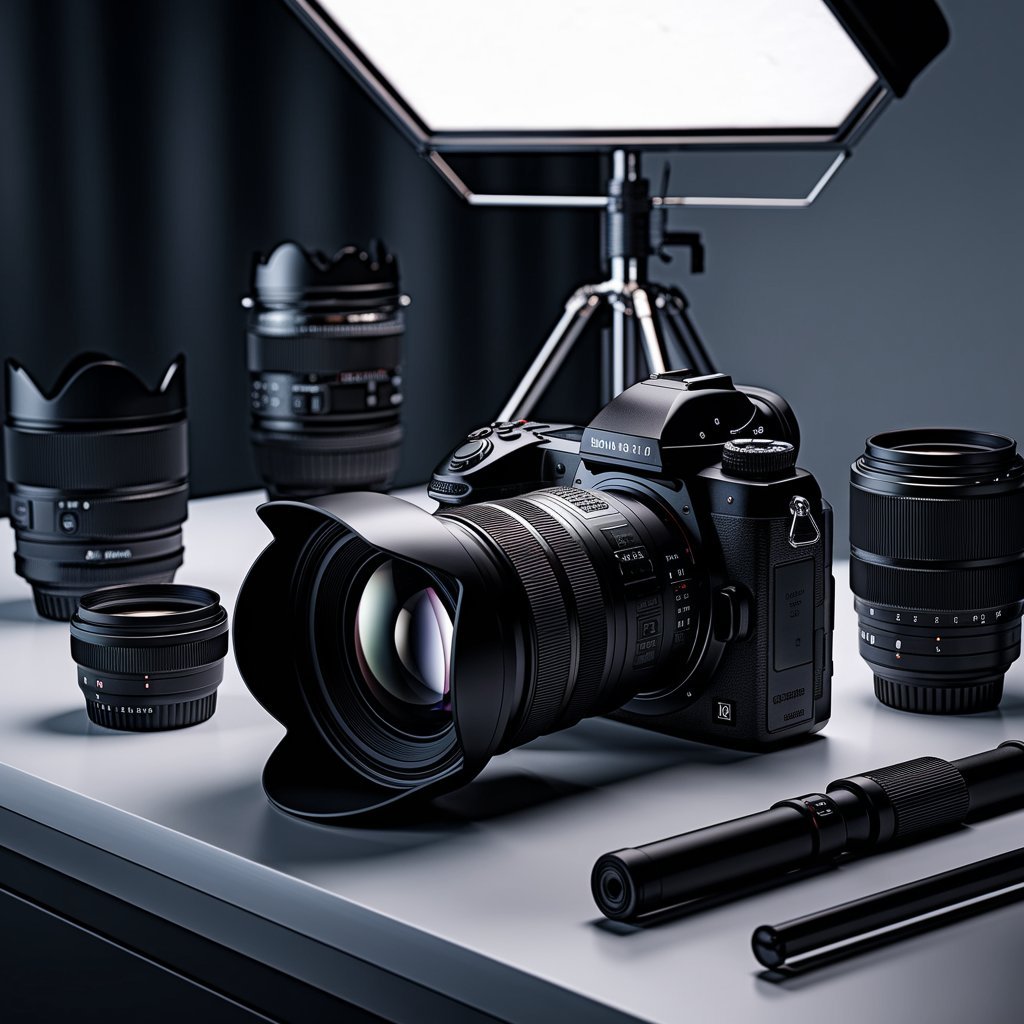For professional photographers, videographers, and content creators, choosing the right camera equipment can make or break a project. The precision, image quality, and flexibility offered by professional-grade cameras are essential for delivering exceptional results. In this in-depth review, we will explore the key features, performance, and value of various professional-grade camera equipment, focusing on cameras, lenses, and accessories that meet the highest industry standards.
Why Professional-Grade Cameras Matter
Professional-grade cameras are built for those who need more than just point-and-shoot convenience. These cameras deliver high-resolution images, full manual controls, and advanced features like interchangeable lenses, robust build quality, and enhanced low-light performance. Unlike consumer-grade cameras, professional equipment is designed for reliability, longevity, and flexibility, making it suitable for commercial photography, filmmaking, and other creative fields.
Key Features of Professional-Grade Cameras
1. Image Sensor
The image sensor is the heart of a camera, responsible for capturing light and converting it into an image. Professional cameras typically use either full-frame or medium-format sensors, both of which offer significant advantages over the smaller sensors found in entry-level cameras.
Full-Frame Sensors: These sensors are the same size as a 35mm film frame, offering superior low-light performance, greater dynamic range, and better image quality. Full-frame cameras are ideal for portraits, landscape photography, and commercial work.
Medium-Format Sensors: These are even larger than full-frame sensors, providing unparalleled image quality with incredibly high resolution. Medium-format cameras are commonly used in studio photography, fashion shoots, and fine art photography.
2. Megapixels
While sensor size plays a significant role in image quality, the number of megapixels (MP) is also crucial. Higher MP cameras can capture more detail, which is essential for large prints, cropping, and commercial photography.
Canon EOS R5: 45 MP
Nikon Z7 II: 45.7 MP
Sony Alpha 1: 50.1 MP
Fujifilm GFX100S: 102 MP (medium-format)
While more megapixels result in greater detail, they also produce larger file sizes, which can be demanding on storage and processing power.
3. Autofocus System
Professional photographers need fast and accurate autofocus to capture fleeting moments. Modern professional-grade cameras come with sophisticated autofocus systems that include multiple focus points, face and eye detection, and continuous autofocus for fast-moving subjects.
Canon EOS R3: Dual Pixel AF with 1,053 AF points
Sony Alpha 1: Real-Time Eye AF for humans and animals, with 759 phase-detection points
Nikon Z9: 493-point phase-detection AF system
Advanced autofocus systems are critical for genres like sports, wildlife, and action photography, where precision is key.
4. Frame Rate and Burst Shooting
For professional photographers who shoot fast-moving subjects, such as in sports or wildlife photography, a camera’s frame rate and burst shooting capabilities are crucial. Burst mode allows the camera to take several photos in rapid succession.
Sony Alpha 1: 30 fps burst shooting at full resolution
Canon EOS R3: 30 fps with electronic shutter
Nikon Z9: 20 fps at full resolution
High frame rates combined with reliable autofocus ensure that photographers never miss a critical shot, even in fast-paced environments.
5. Video Capabilities
In addition to photography, many professional-grade cameras now offer outstanding video performance, making them a go-to tool for videographers, filmmakers, and content creators. Key video features include 4K and 8K recording, high frame rates for slow-motion, and advanced color profiles for grading in post-production.
Canon EOS R5: 8K recording at 30fps, 4K at 120fps
Sony Alpha 1: 8K recording at 30fps, 4K at 120fps
Nikon Z9: 8K at 30fps, 4K at 120fps
These cameras also feature advanced cooling systems to prevent overheating during long recording sessions, as well as external recording options for uncompressed footage.
Professional Lenses: Expanding Your Creative Options
A camera is only as good as the lens you attach to it. Professional photographers use a variety of lenses to capture different perspectives, from wide-angle shots to extreme telephoto views. When reviewing professional-grade camera equipment, it’s essential to consider the lens lineup available for each camera system.
1. Prime Lenses
Prime lenses have a fixed focal length and are known for their sharpness, large apertures, and low-light performance. They are favored by portrait, street, and landscape photographers for their optical quality and ability to create a shallow depth of field.
Canon RF 50mm f/1.2L USM: Known for its sharpness and bokeh, this lens is perfect for portraits.
Nikon Z 85mm f/1.8 S: A classic portrait lens, offering excellent subject isolation and sharpness.
Sony FE 35mm f/1.4 GM: A versatile prime lens that’s perfect for everything from portraits to street photography.
2. Zoom Lenses
Zoom lenses offer variable focal lengths, making them more versatile than primes. Professional zoom lenses are often used for events, sports, and wildlife photography, where photographers need to quickly adapt to changing situations.
Canon RF 24-70mm f/2.8L IS USM: This versatile zoom covers a wide-to-medium focal length, making it ideal for weddings and event photography.
Sony FE 70-200mm f/2.8 GM OSS II: Perfect for sports and wildlife photography, offering fast autofocus and excellent image stabilization.
Nikon Z 14-24mm f/2.8 S: This ultra-wide zoom is a favorite among landscape and architectural photographers.
3. Telephoto Lenses
Telephoto lenses allow photographers to capture distant subjects in high detail, making them indispensable for sports and wildlife photography.
Canon RF 100-500mm f/4.5-7.1L IS USM: A versatile telephoto lens, perfect for wildlife and sports photography.
Sony FE 400mm f/2.8 GM OSS: An ultra-fast telephoto lens, ideal for professional sports photography.
Nikon Z 400mm f/2.8 TC VR S: Designed for the most demanding wildlife and sports photographers.
Accessories: Essential Tools for Professional Photographers
In addition to cameras and lenses, professional photographers rely on a range of accessories to enhance their work.
1. Tripods
A sturdy tripod is essential for long exposure photography, landscape photography, and video work. Carbon fiber tripods are popular among professionals for their lightweight yet robust build.
Manfrotto MT190CXPRO4: A reliable carbon fiber tripod that offers stability and versatility for a variety of shooting conditions.
Gitzo GT5563GS: Known for its rock-solid stability, this tripod is ideal for heavy camera setups in the field.
2. Camera Bags
Professional photographers often need to carry multiple cameras, lenses, and accessories. A well-designed camera bag can make transporting gear much easier and safer.
Lowepro ProTactic 450 AW II: This backpack is known for its durability, spacious design, and quick access to gear.
Think Tank Airport Security V3.0: A rolling camera bag that meets international carry-on size requirements, perfect for traveling photographers.
3. External Flash and Lighting
Controlling light is essential for professional photography. External flashes and lighting equipment help photographers achieve perfect lighting conditions in any scenario.
Profoto B10: A portable and powerful flash system, ideal for location shoots.
Godox V1: A versatile flash with a round head that provides soft and even lighting for portrait photography.
Conclusion: Is Professional-Grade Camera Equipment Worth It?
Investing in professional-grade camera equipment is crucial for photographers who require the best performance, reliability, and image quality. These cameras, lenses, and accessories are designed to handle the demands of professional work, offering advanced features that elevate your photography and videography to new heights. From the powerful autofocus systems to the high-resolution sensors and versatile lens options, professional-grade equipment is built for those who push the boundaries of creativity.
Whether you’re a seasoned photographer or looking to upgrade your current gear, this in-depth review provides a clear understanding of what to expect from the top-tier professional-grade camera systems available today.
.





